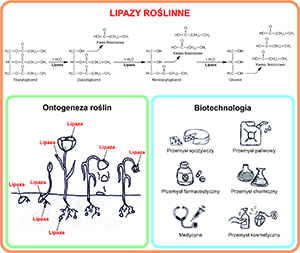Plant lipases – molecular structure, role in ontogeny and biotechnological potential
DOI:
https://doi.org/10.18388/pb.2021_539Abstract
Lipases are enzymes commonly found in microorganisms, fungi, plants and animals. Their main function in cell metabolism is the hydrolysis (lipolysis) of ester bonds between fatty acids and glycerol in mono-, di- and triacylglycerols. In plants, lipases play an important role in ontogeny, participating in both vegetative development and generative stages. These enzymes may also be a component of plant responses to biotic and abiotic stresses. Based on the similarity of the amino acid sequence and vacuolar localization of some plant lipases to yeast Atg15, we present a hypothesis about the participation of lipases in autophagy (precisely, in the degradation of the autophagic body) in plants. Despite the narrow substrate specificity and the type of reactions catalysed in cells, lipases find numerous biotechnological applications. The physicochemical features of lipases, which determine, for example, wide substrate specificity in vitro or high stability in a wide range of pH and temperature, make these enzymes the subject of applied research, and plant lipases show an increasing potential in this area of science and industry.
Downloads

Published
Issue
Section
License
Copyright (c) 2024 Alan Stafiej, Karolina Wleklik, Marta Przybylak, Sławomir Borek

This work is licensed under a Creative Commons Attribution 4.0 International License.
All journal contents are distributed under the Creative Commons Attribution-ShareAlike 4.0 International (CC BY-SA 4.0) license. Everybody may use the content following terms: Attribution — You must give appropriate credit, provide a link to the license, and indicate if changes were made, ShareAlike — If you remix, transform, or build upon the material, you must distribute your contributions under the same license as the original. There are no additional restrictions — You may not apply legal terms or technological measures that legally restrict others from doing anything the license permits.
Copyright for all published papers © stays with the authors.
Copyright for the journal: © Polish Biochemical Society.



